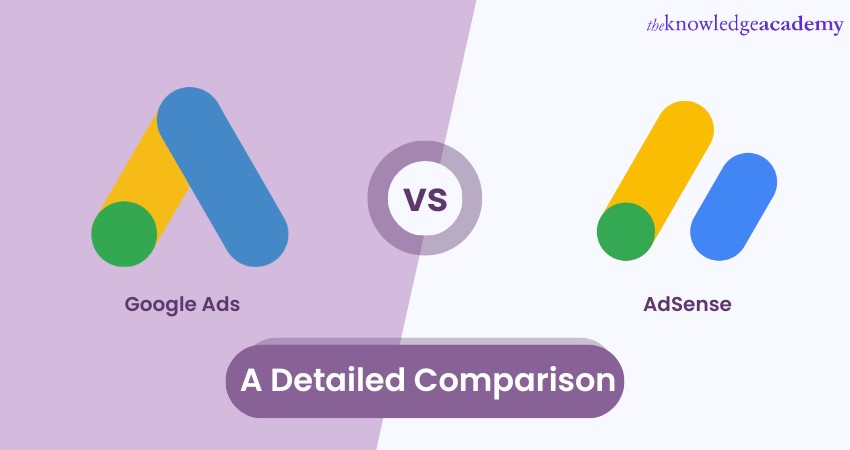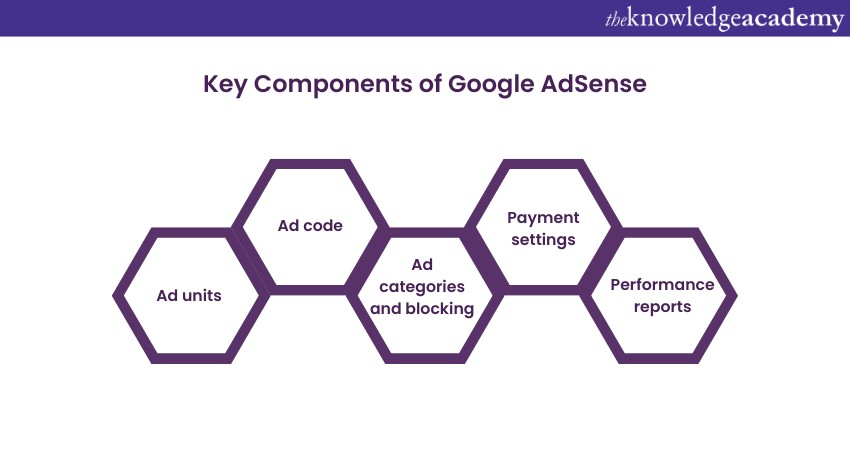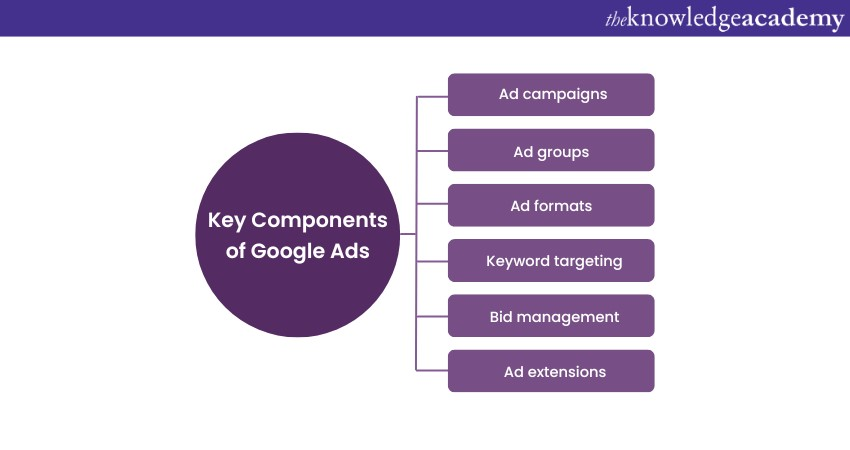We may not have the course you’re looking for. If you enquire or give us a call on 01344203999 and speak to our training experts, we may still be able to help with your training requirements.
Training Outcomes Within Your Budget!
We ensure quality, budget-alignment, and timely delivery by our expert instructors.

In the world of online advertising, Google plays a dominant role with two powerful advertising platforms - Google Ads and AdSense. Google Ads vs Google AdSense are two distinct advertising platforms offered by Google, each serving different purposes and catering to diverse audiences. Understanding the differences between Google Ads and AdSense is crucial for advertisers and website owners looking to monetise their online presence.
In this blog, we'll explore Google Ads vs Google AdSense, which helps you make informed decisions for your advertising and revenue-generation strategies.
Table of content
1) What is Google Ads?
2) Key components of Google Ads
3) What is Google AdSense?
4) Key components of Google AdSense
5) Difference between Google Ads and AdSense
6) Conclusion
What is Google Ads?
Google Ads, formerly Google AdWords, is an online advertising platform developed by Google. It's one of the most widely used and effective advertising tools for businesses and individuals looking to promote their products, services, or content online. Google Ads allows advertisers to create and manage various types of ads that appear on Google's Search Engine Results Pages (SERPs) and on websites, mobile apps, and video content within Google's extensive advertising network.

Key components of Google Ads
Here are the essential components of Google Ads:

1) Ad campaigns: Advertisers can create multiple ad campaigns, each with specific goals and settings, such as campaign type, budget, and target audience.
2) Ad groups: Advertisers organise their ads into ad groups within each campaign. Ad groups allow for better ad targeting and ad variations.
3) Ad formats: Google Ads offers various ad formats, including text ads, display ads, video ads, app promotion ads, and shopping ads. Advertisers can choose the format that suits their advertising goals.
4) Keyword targeting: Advertisers select keywords and phrases relevant to their products or services. Ads are triggered when users search for these keywords on Google.
5) Bid management: Advertisers set bids, specifying the maximum amount they are willing to pay for each click (Cost Per Click, or CPC) or impression (Cost Per Mille, or CPM). Bids determine ad placement.
6) Ad extensions: Ad extensions provide additional information, such as location, phone number, links to specific pages, and more. They enhance the visibility and relevance of ads.
Supercharge your online advertising skills with our Google Ads Masterclass. Register now to drive results and boost your business!
What is Google AdSense?
Google AdSense is a popular online advertising program developed by Google. Unlike Google Ads, which are designed for advertisers looking to promote their products or services, Google AdSense is tailored for website owners, bloggers, and publishers wanting to monetise their online content.
Key components of Google AdSense
Here are the key components of Google AdSense:

1) Ad units: AdSense provides various types of ad units, including display ads, in-feed ads, in-article ads, matched content, and auto ads. Publishers can choose the most suitable format for their website's layout and content.
2) Ad code: Google provides publishers with unique ad codes that must be placed on their websites. This code connects their website to the AdSense program and displays relevant ads.
3) Ad categories and blocking: Publishers can specify the types of ads they want to appear on their website by selecting ad categories. They can also block specific categories or individual ads to control content relevance.
4) Payment settings: Publishers set up their payment information, including preferred payment methods and payment thresholds. AdSense provides earnings reports and pays out earnings once they reach the specified threshold.
5) Performance reports: AdSense offers detailed performance reports, including metrics like impressions, Click-Through Rates (CTR), earnings, and ad unit performance. This data helps publishers track their ad revenue and make informed decisions.
Unlock your website's earning potential with our Google AdSense Masterclass. Join now and maximise your ad revenue!
Difference Between Google Ads and AdSense
Now, we'll delve deeper into the key differences between Google Ads and AdSense, helping you understand which platform suits your advertising or revenue-generation needs.
Application
The primary difference between Google Ads and AdSense lies in their application process. Google Ads is designed for advertisers; anyone can create an account to run ad campaigns. Advertisers set budgets, create ad content, and target specific keywords or audiences. In contrast, AdSense is intended for website owners and publishers. They must apply to be part of the AdSense program, and Google reviews their websites to ensure they meet certain quality and content guidelines before displaying ads.
Transaction
Advertisers pay for their ads in Google Ads based on the Pay-Per-Click (PPC) model. They're charged when a user clicks on their ad. Advertisers set a budget and bid on keywords, and they pay for actual clicks. On the other hand, in AdSense, website owners earn money when users click on the ads displayed on their sites. AdSense operates on a revenue-sharing model, and website owners receive some revenue from ad interactions.
Setup procedure
Google Ads and AdSense also differ in their setup procedures. Setting up Google Ads involves creating ad campaigns, selecting keywords, and defining targeting parameters. Advertisers need to craft ad copy and set bids. With AdSense, website owners integrate the program by placing ad code on their websites, and Google's algorithms select and display ads. The setup for AdSense is generally more straightforward for website owners than the complexities of managing ad campaigns in Google Ads.
Advertisement quota
Google Ads allows advertisers to create and run as many ad campaigns as they want, provided they have the budget to support them. In contrast, AdSense does not limit website owners in terms of the number of ads they can display. The quota of ads in AdSense is largely dependent on the available ad inventory and user interactions on the website.
Categories of advertisements
Google Ads offers a wide range of ad formats, including text, display, video, and more. Advertisers can choose the type that best suits their marketing goals. As a platform for publishers, AdSense primarily focuses on display ads, but it also offers in-feed ads, in-article ads, matched content, and auto ads. The range of ad categories and formats in AdSense is somewhat more limited than the variety available in Google Ads.
Advertising enhancement choices
Google Ads provides advertisers with advanced tools for targeting, audience segmentation, bidding strategies, and ad extensions, allowing for more fine-tuned advertising campaigns. AdSense offers limited customisation options for publishers to control the look and feel of ads on their websites, emphasising user experience.
These differences highlight the contrasting roles and functionalities of Google Ads and AdSense, one serving advertisers aiming to reach their target audience and the other assisting website owners in generating revenue through ad monetisation.
Unlock the power of data with our Google Analytics Masterclass. Join today and transform your insights into action!
Conclusion
To sum it up, understanding the differences between Google Ads vs AdSense is essential for anyone involved in online advertising or website monetisation. These two platforms, while both products of Google, serve distinct purposes and cater to different user groups.
Elevate your digital marketing skills today! Explore our Digital Marketing Courses and stay ahead in the online world!
Frequently Asked Questions
Upcoming Batches & Dates
Date








 Top Rated Course
Top Rated Course


 If you wish to make any changes to your course, please
If you wish to make any changes to your course, please


